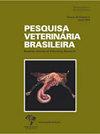肉鸡艾美耳球虫的显微、组织病理学和PCR诊断比较
IF 0.8
4区 农林科学
Q3 VETERINARY SCIENCES
引用次数: 2
摘要
摘要:球虫病是一种重要的工业家禽疾病。正确的诊断指导家禽业采取最佳的治疗和控制措施。为此,对64只平均29日龄肉鸡进行了艾美耳亚种肠道调查。每群随机取8只肉鸡出屠宰线,共512只样品。肠内肉眼及组织病理学病变分为0 ~ 4分。采用聚合酶链反应(PCR)技术对7种艾美耳球虫卵囊的肠道内容物进行了研究。宏观评价结果显示,59.4%(38/64)的鸡群棘突埃希菌阳性,32.8%(21/64)的鸡群最大埃希菌阳性,29.7%(19/64)的鸡群柔嫩埃希菌阳性,34.4%(22/64)的鸡群布鲁内蒂埃希菌阳性。组织病理学鉴定结果显示,87.5%(56/64)的鸡群中至少有1只与艾美耳虫寄生结构相匹配的肉鸡存在于十二指肠,70.3%(45/64)存在于空肠,18.8%(12/64)存在于回肠,46.9%(30/64)存在于盲肠,4.7%(3/64)存在于结肠。PCR检测结果显示,尖头棘球绦虫阳性率为21.9%(14/64),最大棘球绦虫阳性率为12.5%(8/64),米氏棘球绦虫阳性率为3.1%(2/64),柔毛虫阳性率为32.8%(21/64)。Kappa Cohen检验显示,除了盲肠的组织病理学和PCR结果较强外,宏镜、组织病理学和PCR结果之间的一致性从弱到中度不等。宏镜与组织病理学比较,0分与1分(盲肠除外)差异有统计学意义。评分3时,十二指肠、空肠和盲肠的差异有统计学意义(p<0.05)。综上所述,肉眼诊断和PCR可能会产生假阴性结果,而组织病理学检查是有效的,因此需要结合不同的技术来正确诊断肉仔鸡艾美耳虫。本文章由计算机程序翻译,如有差异,请以英文原文为准。
Comparison of macroscopy, histopathology and PCR for diagnosing Eimeria spp. in broiler chickens
ABSTRACT: Coccidiosis is a disease of great importance in industrial poultry. The correct diagnosis directs the poultry industry to its best treatment and control. Thus, a survey of Eimeria spp. was carried out in intestines of 64 broiler flocks, with an average age of 29 days. Eight broilers from each flock were randomly removed from the slaughter line, in a total of 512 samples. Macroscopic and histopathological lesions in the intestine were classified into Scores 0 to 4. Polymerase chain reaction (PCR) was used to research the oocysts from the seven species of Eimeria spp. in the intestinal content. The macroscopic evaluations showed that 59.4% (38/64) of the flocks were positive for E. acervulina, 32.8% (21/64) for E. maxima, 29.7% (19/64) for E. tenella, and 34.4% (22/64) for E. brunetti. The histopathological evaluation showed that 87.5% (56/64) of the flocks had at least one broiler with parasitic structures compatible with Eimeria spp. in the duodenum, 70.3% (45/64) in the jejunum, 18.8% (12/64) in the ileum, 46.9% (30/64) in the cecum, and 4.7% (3/64) in the colon. In PCR, 21.9% (14/64) of the flocks were positive for E. acervulina, 12.5% (8/64) for E. maxima, 3.1% (2/64) for E. mitis, and 32.8% (21/64) for E. tenella. The Kappa Cohen test between macroscopy, histopathology, and PCR demonstrated concordance ranging from weak to moderate with the exception of histopathology and PCR of the cecum, which was strong. In the comparison between macroscopy and histopathology, there were significative differences between Scores 0 and 1 (apart from the cecum). For Score 3, there were significative differences in duodenum, jejunum and cecum (p<0.05). In conclusion, the macroscopic diagnosis and PCR can generate false-negative results, and the histopathological exam proved to be effective, making it essential to associate different techniques for the correct diagnosis of Eimeria spp. in broiler chickens.
求助全文
通过发布文献求助,成功后即可免费获取论文全文。
去求助
来源期刊

Pesquisa Veterinaria Brasileira
农林科学-兽医学
CiteScore
1.30
自引率
16.70%
发文量
41
审稿时长
9-18 weeks
期刊介绍:
Pesquisa Veterinária Brasileira - Brazilian Journal of Veterinary Research (http://www.pvb.com.br), edited by the Brazilian College of Animal Pathology in partnership with the Brazilian Agricultural Research Organization (Embrapa) and in collaboration with other veterinary scientific associations, publishes original papers on animal diseases and related subjects. Critical review articles should be written in support of original investigation. The editors assume that papers submitted are not being considered for publication in other journals and do not contain material which has already been published. Submitted papers are peer reviewed.
The abbreviated title of Pesquisa Veterinária Brasileira is Pesqui. Vet. Bras.
 求助内容:
求助内容: 应助结果提醒方式:
应助结果提醒方式:


